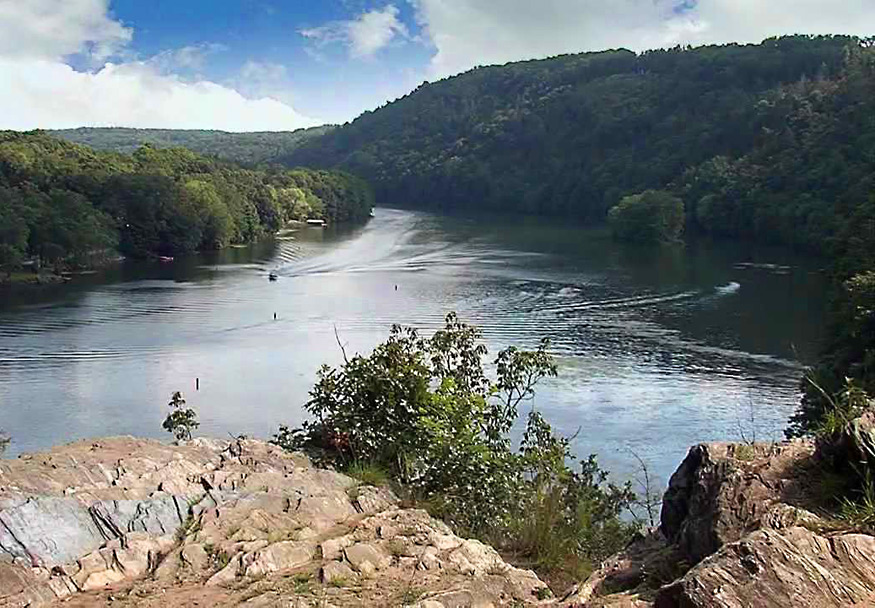The following is excerpted from a 2016 book by Peter Tomaino entitled, Lover’s Leap: Then and Now. You can purchase it on Amazon: CLICK HERE
THE LILLINONAH’S LEAP LEGEND
 Once upon a time, as the tale is told in Tomaino’s book, sometime in the mid 1600s, Princess Lillinonah, the daughter of the Great Native American Chief, Sachem Waramaug, was walking in the forest on Great Mountain, which is now the Lover’s Leap area. During her walk, she spotted a white youth also exploring. She had heard about the white man, but had never seen one before, especially this far north. Princess Lillinonah eventually revealed herself to the white youth and took him to an ancient fishing cove below what the Native Americans named the Great Fall of Metichewan, which is now called Lover’s Leap.
Once upon a time, as the tale is told in Tomaino’s book, sometime in the mid 1600s, Princess Lillinonah, the daughter of the Great Native American Chief, Sachem Waramaug, was walking in the forest on Great Mountain, which is now the Lover’s Leap area. During her walk, she spotted a white youth also exploring. She had heard about the white man, but had never seen one before, especially this far north. Princess Lillinonah eventually revealed herself to the white youth and took him to an ancient fishing cove below what the Native Americans named the Great Fall of Metichewan, which is now called Lover’s Leap.
THE LEGEND PART
Princess Lillinonah took “White Youth Found Wandering” back to her village to meet her father, Chief Waramaug. Surprisingly, the Chief welcomed him, and invited the boy to stay for the season. The Princess and “White Boy Wandering” eventually fell deeply in love and Lillinonah asked the Chief if they could marry. Chief Waramaug told them he needed to walk to his favorite high place, Pinnacle Rock and meditate on his daughter’s request.
To make an exceptionally long story much shorter, the Chief sent “White Youth Found Wandering” back to his people to tell them of his plan to marry his daughter, and then once he returned, they could marry. The young man did not return, and Chief Waramaug promised the Princess to a Chief of the Wepawaug Tribe. Lillinonah was having none of that, vowing only to marry her true love.
On the day of her wedding, dressed in her deerskin bridal gown, she snuck away into the forest and headed to a birch bark canoe she had hidden away to execute her plan of riding the current, and eventually, letting her canoe fall over the precipice of the Great Fall of Metichewan (Lover’s Leap). If she couldn’t marry her one true love, there was no reason to go on.
You guessed it. Her love had returned and was running up on the ridge trying to somehow save her from being flung over the 100-foot drop of the waterfall (considered the Niagra Falls of New England).
Princess Lillinonah looked up and their eyes locked. “White Youth Found Wandering” immediately leaped off the cliff trying to get to the Princess. As Lillinonah reached out, they embraced one last time before, “They were swept away in the thundering mist below and were married in the arms of the Great Spirit.”
They say that when the battered bodies of the star-crossed lovers were finally found, they were still locked in each other’s arms. Noble, even in deepest mourning for his lost Lillinonah, Chief Waramaug ordered that his daughter and her white lover be buried side by side, contrary to Indian tradition, on the top of a hill overlooking the narrow gap of the Housatonic River now known as Lover’s Leap. And when old Waramaug finally joined his ancestors many sad years later, legend says that he, too, was laid to rest near the ill-fated couple. Though the tragic life of Lillinonah ended centuries ago, her legend will never be forgotten. Any Connecticut map will show that the wide portion of the Housatonic River which stretches for miles below the narrow rapids where the lovers met their deaths is, to this day, still called Lake Lillinonah.

